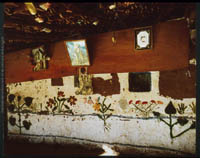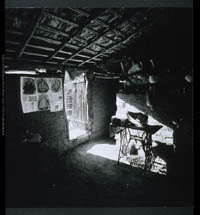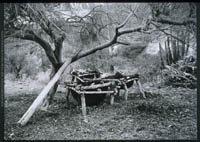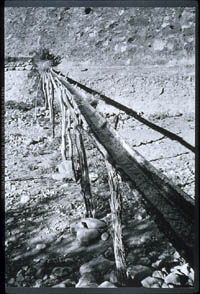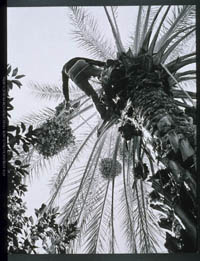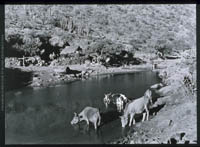|
|
Ranches for the Peninsular
Gentry ...continued
- Drawing
water at Rancho de los Pozos, 1971
Many rural people depend for life and livelihood on hand dug wells,
often to heroic depths. In the mid-peninsula several descend three
hundred feet. Windmills are expensive and require maintenance. At
some ranches, water is regularly raised from those great depths
by means of burro or mule power. A child or an oldster directs the
animal while a man or woman awaits the bucket, swings it out of
the wellhead, and dumps it into a barrel or watering trough. The
process is usually repeated for an hour or two, once or twice a
day.
- Kitchen
scene at Rancho de Pie de la Cuesta, 1971
Baja California ranch cooks produce savory dishes despite the limitations
of adobe stoves fired with hardwood twigs. Tortillas and beans are
standard fare, but the rest of the cuisine is not that usually associated
with Mexico. Principal dishes are a sopa, consisting of rice or
pasta and a mixture of cut up onions and other vegetables cooked
in broth, and a guisado, beef, fish, or turtle sautéed with
onions, chiles, garlic, potatoes, or other vegetables-a ranch stir
fry. Kitchens often appear to be the flimsiest structures at a ranch
because their sides are infilled only with woven rushes or small
branches to assure air movement during the central peninsula's long
hot season.
- Kitchen
scene at Rancho de la Vinorama [de arriba], 1980
When the weather is cold or when the wind is howling, social life
moves from the corredor into the kitchen. The more isolated the
ranch, the warmer the welcome awaiting visitors. They are plied
with coffee and encouraged to impart whatever news or gossip they
can recall. Hosts often have a list of dozens of relatives to ask
about, so inter-related is the population in all the central and
southern parts of the peninsula.
- Berta's
mural at Rancho de Santa Marta, 1973
Berta Ojeda Arce decorated the plaster wall in the corredor of her
home when she was eleven. Family and passersby admired her work
and there it remained after Berta was grown, married, and moved
away.
|
|
|
Centuries-old Devices
May Remain in Use into the Twenty-First Century
To this day there is no
electric power at sierra ranches. All sorts of manual machinery that we no longer
use and handcrafts that we no longer practice are part of everyday life a few
hundred miles south of us.
- Treadle
sewing machine at Rancho de Pie de la Cuesta, 1971.
- Grindstone
at Rancho de Guadalupe, 1980.
- Tanning
Vats at Rancho de San Nicolás, 1971.
Until recently, leather was tanned at a few ranches in each sierra
from mid-peninsula to the cape. Competition from large tanneries
in Sonora and the interior of Mexico has reduced demand and this
wonderful old craft-along with fine regional leatherwork-is becoming
rare and even endangered.
- Flume
at Rancho de San Gregorio, 1971
Water is rare; sources of water near irrigatable plots of ground
are rarer still. At Rancho de San Gregorio, water has to be brought
a quarter of a mile in open channels cut into the rock and flumes
that pass across an arroyo. Planting areas had to be built with
high stone walls and filled with earth painstakingly brought in
leather bags on burroback from hundreds of tiny deposits found within
a radius of three or four miles.
- Picking
dates at Rancho de San Martín, 1980
The extensive stands of date palms at San Ignacio, Mulegé,
and Todos Santos are well known. Few people suspect that scores
of lesser sites, including some in large arroyos in the sierras,
have subterranean waters that support up to several dozen palms.
- Cattle
in the tinaja at Rancho del Zorillo, 1980
Some hard rock water catchments are very large but shallow. Great
quantities of water accumulate in minutes during the occasional
summer storm, but, in a matter of a few weeks, the waters evaporate
or drain out through crevices in the underlying rock. Local people
take advantage of this ephemeral bounty by bringing goats and cattle
to the larger pools. In this way, they use not only the water but
also the verdure that responds to the same rains that fill the basins.
|

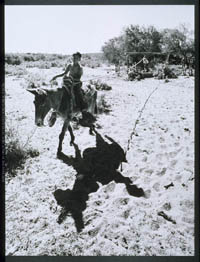
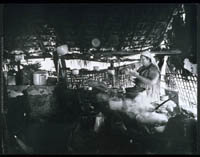
![Kitchen scene at Rancho de la Vinorama [de arriba], 1980](crosthum/M333-43M.jpg)
